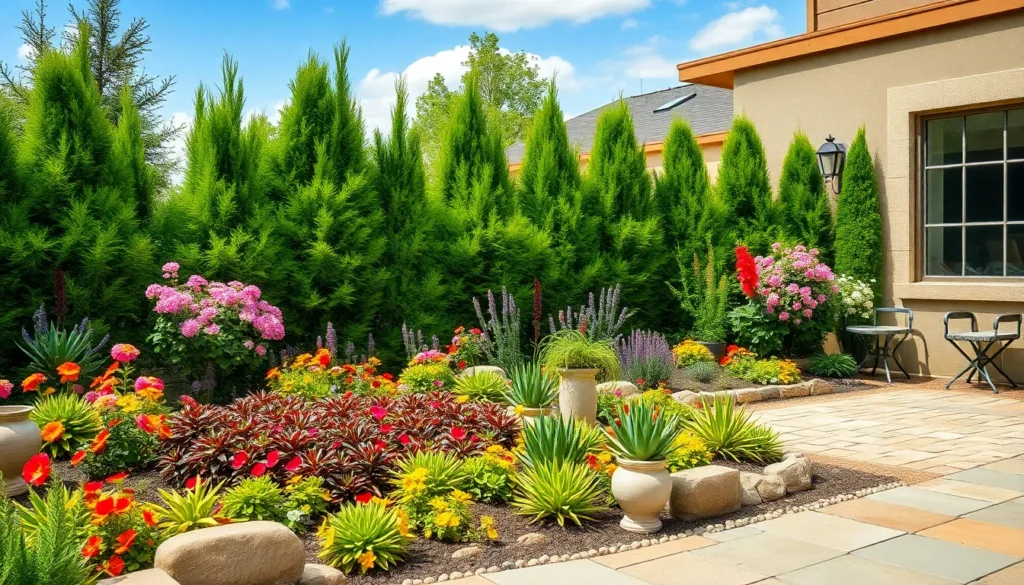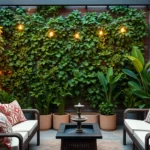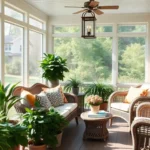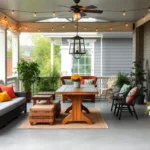Transform your outdoor space from ordinary to extraordinary with stunning patio border landscaping that’ll make your neighbors take notice. We’ve discovered that the right border design doesn’t just define your patio – it creates a seamless flow between your indoor and outdoor living spaces while boosting your home’s curb appeal and value.
Whether you’re working with a sprawling backyard or a cozy urban patio we’ll show you how strategic border landscaping can maximize your space’s potential. From low-maintenance succulent gardens to lush perennial borders that bloom all season long there’s a perfect solution waiting for your unique style and budget.
Ready to create the patio oasis you’ve always dreamed of? We’re sharing our favorite border landscaping ideas that combine beauty functionality and year-round appeal to give you the outdoor sanctuary you deserve.
Define Your Patio Border Style and Purpose
We’ll need to establish the foundation of your patio landscaping project by determining both aesthetic preferences and practical requirements. Successful border designs stem from understanding your space’s unique characteristics and intended use.
Formal vs. Informal Border Designs
Formal border designs create structured elegance through geometric patterns and carefully maintained plantings. We see boxwood hedges, manicured rose beds, and symmetrical layouts dominating these sophisticated spaces. Clean lines define pathways while matching planters on either side establish visual balance. Formal styles work exceptionally well with traditional architecture like colonial homes, Mediterranean villas, and contemporary minimalist designs.
Informal border designs embrace natural flowing curves and mixed plant combinations for a relaxed cottage garden feel. We prefer ornamental grasses, wildflower patches, and climbing vines that spill over edges in these casual settings. Varied heights create visual interest while seasonal blooms provide changing color palettes throughout the year. Informal approaches complement farmhouse styles, craftsman bungalows, and rustic outdoor living spaces perfectly.
Transitional styles blend both approaches by incorporating structured elements with softer plant choices. We might use formal hardscaping materials like stone edging while allowing perennials to grow in natural clusters. This versatile option works with most architectural styles and allows homeowners to experiment with different looks over time.
Functional Considerations for Border Planning
Privacy screening ranks as our top functional priority for many patio border projects. We recommend evergreen shrubs like arborvitae, privet hedges, or bamboo screens that provide year round coverage. Dense plantings at 4 to 6 feet heights effectively block unwanted views while creating intimate outdoor rooms. Strategic placement near seating areas maximizes privacy without overwhelming smaller spaces.
Traffic flow management requires careful plant placement to guide movement around your patio area. We position taller borders along property lines while keeping walkway edges at 12 to 18 inches maximum height. Clear sight lines prevent accidents while defined pathways direct guests toward seating areas and outdoor amenities. Consider maintenance access when planning permanent installations.
Seasonal interest ensures your patio borders look attractive throughout all four seasons. We select plants with varying bloom times, interesting bark textures, and colorful fall foliage for continuous appeal. Spring bulbs provide early color while summer perennials offer peak flowering periods. Winter structure comes from evergreen elements and ornamental seed heads left standing.
Maintenance requirements directly impact long term satisfaction with your border landscaping choices. We factor in available time, physical capabilities, and budget constraints when selecting plants and design complexity. Low maintenance options include native plants, drought tolerant species, and slow growing shrubs that require minimal pruning.
Create Natural Stone Border Edges
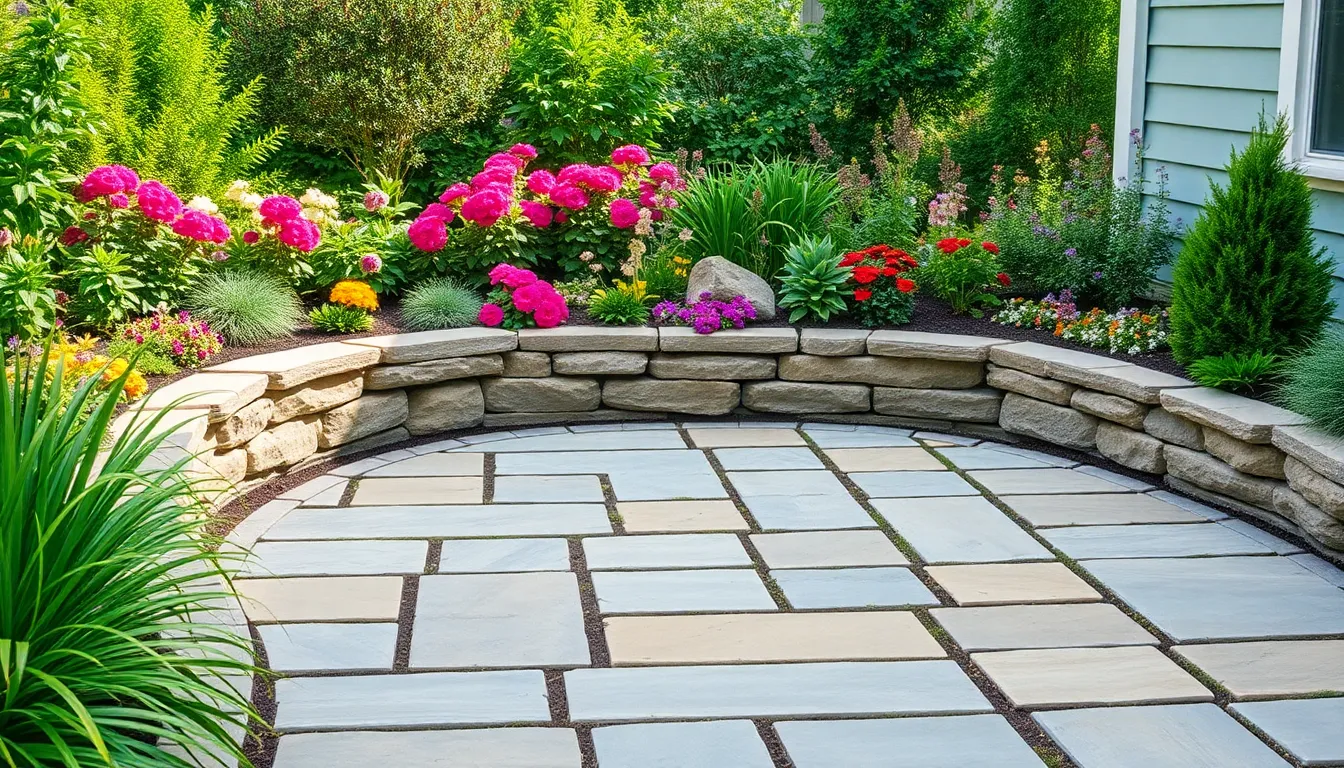
Natural stone borders bring timeless elegance to any patio space while providing the structural foundation your outdoor area needs. We’ll explore three distinct approaches that transform ordinary patio edges into stunning industry features.
Flagstone Border Installation
Flagstone creates clean, sophisticated borders that complement both rustic and formal patio designs. We recommend laying these flat stones in either linear or staggered patterns directly on a leveled base of sand or gravel. This installation method ensures proper drainage while creating smooth, elegant transitions around your patio perimeter.
Professional installation typically involves preparing a stable foundation that prevents shifting over time. We’ve found that flagstone’s naturally flat surface makes it ideal for creating uniform edges that resist wear and weather conditions. The material’s versatility allows you to match various patio styles, from contemporary minimalist designs to traditional garden settings.
River Rock and Pebble Arrangements
River rocks and pebbles offer a relaxed, organic approach to patio border design that enhances drainage naturally. We suggest arranging these rounded stones as single or double layer borders, mixing them with mulch and complementary plants for softer transition zones. This combination creates visual interest while reducing weed growth around your patio edges.
Color variation becomes a key benefit when using river rock arrangements, as these materials provide smooth textures that work exceptionally well in water efficient landscapes. We recommend this approach for casual garden designs and xeriscape environments where low maintenance meets natural beauty.
Stacked Stone Wall Borders
Stacked stone walls create pronounced, architectural borders that add both height and visual drama to patio spaces. We can construct these using dry stacked or mortared techniques, depending on your exact needs for retaining walls or raised border edges. Natural fieldstone, limestone, and manufactured stone veneer all work excellently for these applications.
Stone walls provide additional seating opportunities while creating durable barriers between patio spaces and garden beds. We’ve observed that these structures serve dual purposes, offering both functional separation and aesthetic enhancement that increases property value over time.
Install Decorative Brick and Pavers
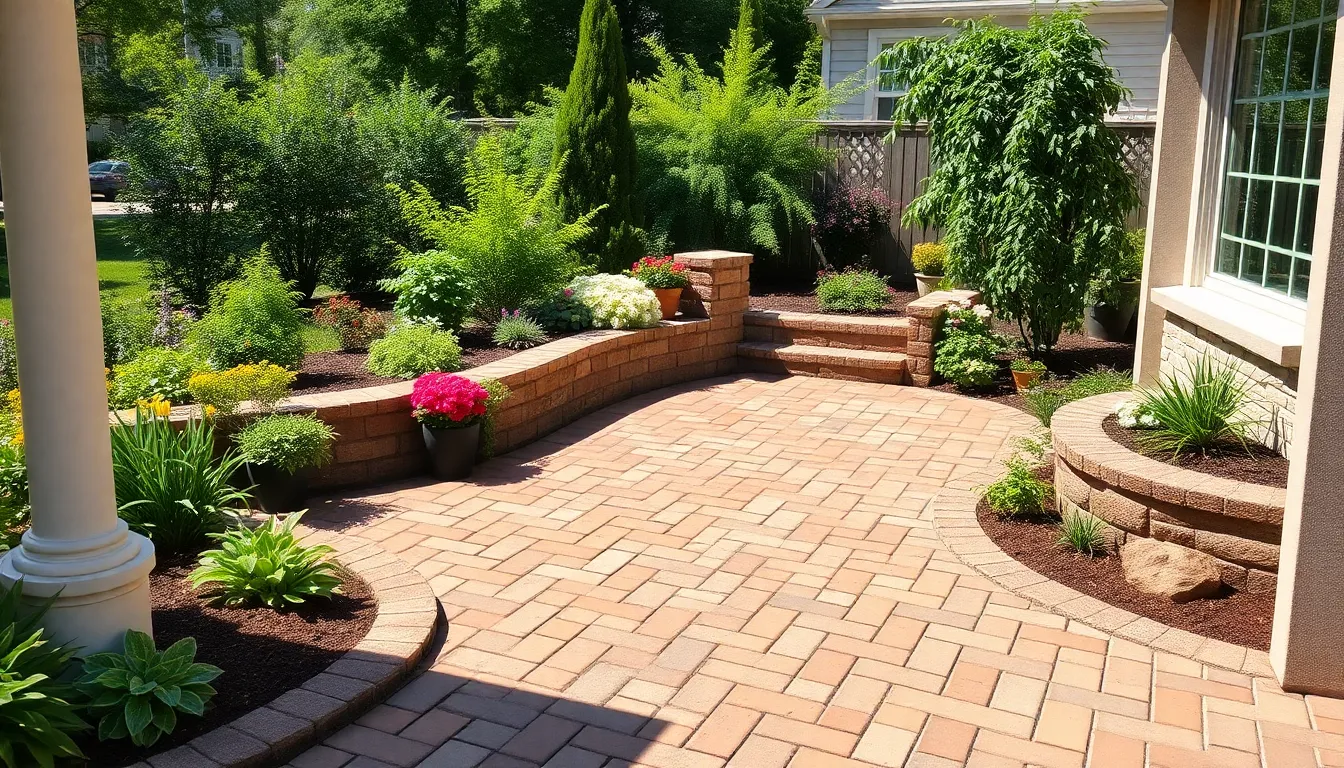
Brick and paver borders bring timeless elegance to any patio space while providing durable, long-lasting edges that withstand weather and foot traffic. We’ve found these materials offer unmatched versatility in creating both classic and contemporary looks that enhance your outdoor living area.
Traditional Brick Border Patterns
Running bond patterns create the most recognizable and enduring brick border design for patios. We recommend this classic layout for homeowners seeking a structured, architectural edge that complements traditional landscaping styles. The staggered brick placement provides visual continuity while maintaining clean lines around your patio perimeter.
Basketweave patterns offer another traditional option that adds textural interest to patio borders. This alternating horizontal and vertical brick arrangement creates a woven appearance that works exceptionally well with cottage garden styles and rustic outdoor themes. We find this pattern particularly effective when using reclaimed or weathered bricks that enhance the vintage aesthetic.
Herringbone layouts deliver sophisticated geometric appeal through their distinctive zigzag brick arrangement. This pattern requires precise installation but rewards homeowners with borders that command attention and elevate the entire patio design. We suggest herringbone patterns for formal garden settings where architectural detail matters most.
Interlocking Paver Designs
Cobblestone paver systems provide exceptional durability while creating borders with Old Industry charm. These interlocking units come in multiple colors and sizes, allowing us to customize the look to match existing hardscaping elements. The precision fit prevents shifting and settling while maintaining clean border lines year after year.
Geometric paver patterns enable creative expression through shapes like hexagons, circles, and diamond configurations. We’ve seen these designs transform ordinary patio borders into striking focal points that complement modern industry architecture. The interlocking mechanism ensures structural integrity while supporting unlimited pattern possibilities.
Modular paver systems offer the ultimate flexibility for complex border installations around curved patios or irregular spaces. These units connect seamlessly regardless of angle changes, making them ideal for challenging installations where traditional bricks might require extensive cutting. We appreciate how these systems maintain pattern continuity even through directional changes.
Mixed Material Combinations
Stone and brick combinations create ever-changing borders that blend natural textures with manufactured precision. We layer fieldstone or river rock between brick courses to achieve organic transitions that soften hard edges while maintaining structural definition. This approach works particularly well for transitional garden styles that balance formal and informal elements.
Gravel and paver pairings deliver excellent drainage benefits while adding textural contrast to patio borders. The gravel fills gaps between pavers and extends beyond the border edge, creating gradual transitions into planted areas. We recommend decomposed granite or pea gravel for colors that complement brick and stone materials.
Wood and brick integrations bring warmth to patio borders through natural material contrasts. Railway sleepers or cedar timbers create raised borders that frame brick paving, while log rolls provide rustic edges that transition beautifully into woodland garden settings. These combinations require proper drainage considerations to prevent wood deterioration but offer unique aesthetic possibilities.
Terracotta tile accents introduce Mediterranean flair when combined with traditional brick borders. We incorporate decorative tiles as header courses or corner elements that break up long brick runs with colorful patterns. This approach works especially well in southwestern and Spanish colonial industry designs where warm earth tones dominate the color palette.
Design Living Plant Borders
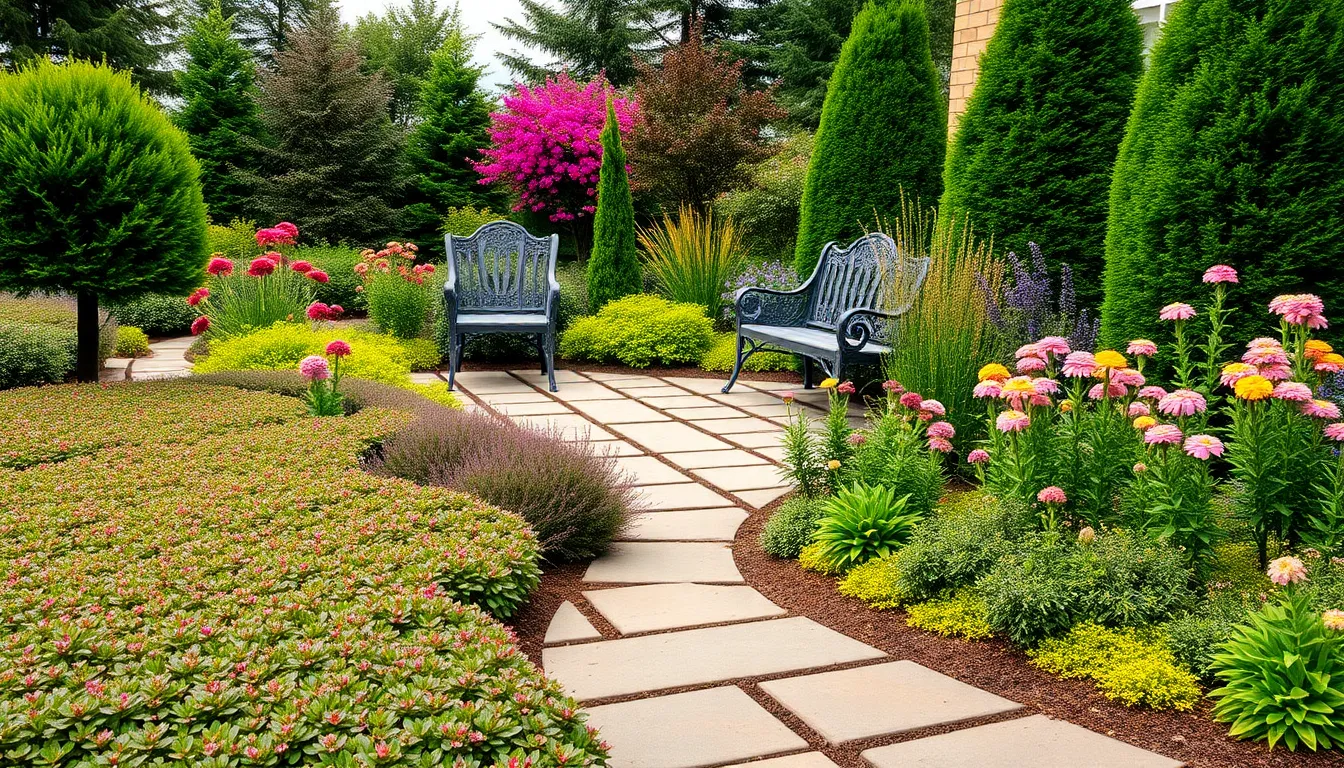
Living plant borders transform ordinary patios into lush, natural extensions of your outdoor space. We’ll explore how strategic plantings create stunning boundaries that enhance both beauty and functionality.
Low-Growing Perennial Options
Compact perennials offer the perfect foundation for patio borders that require minimal upkeep while delivering maximum visual impact. Creeping thyme creates a fragrant carpet effect along patio edges, releasing its signature aroma when walked upon or brushed against. Sedum varieties provide succulent texture and seasonal color changes, from vibrant greens in spring to rich purples and reds in fall.
Ajuga forms dense, low-growing mats with glossy leaves and spikes of purple, blue, or white flowers that bloom in late spring. These hardy perennials stay compact throughout growing seasons, typically reaching heights of 3 to 6 inches. Their ability to soften hardscape edges makes them ideal for transitioning between stone patios and garden beds.
Multiple varieties can be combined to create layered interest and extended blooming periods. Consider mixing different textures like the fine foliage of creeping thyme with the broader leaves of ajuga for visual contrast. These plants thrive in most soil conditions and require minimal watering once established.
Evergreen Shrub Boundaries
Structured evergreen boundaries provide year-round definition and privacy for patio spaces. Boxwood hedges maintain their dense, compact form through regular trimming, creating formal lines that complement both traditional and contemporary patio designs. These shrubs can be shaped into various heights from 12 inches to 4 feet, depending on your privacy and aesthetic needs.
Privet offers faster growth rates than boxwood while maintaining excellent shaping capabilities. Yew shrubs provide darker green foliage and tolerate heavy pruning, making them perfect for creating geometric patterns or maintaining precise boundaries. Their consistent color and density help define outdoor rooms within larger industry designs.
Informal evergreen borders work well with smaller shrubs that naturally maintain compact shapes without frequent trimming. Dwarf varieties of juniper, pine, or spruce create softer boundaries while still providing structure. These options complement stone and paver edging materials by offering a natural backdrop that enhances hardscape elements.
Seasonal Flower Border Ideas
Ever-changing flower combinations keep patio borders vibrant and captivating throughout the year. Spring bulbs like daffodils and tulips provide early season color, followed by summer annuals such as petunias and marigolds that bloom continuously until frost. Pansies extend the growing season into cooler months, offering cheerful faces even in mild winter climates.
Layered planting strategies maximize visual impact by combining different bloom times and heights. Plant taller perennials like coneflowers or black-eyed Susans in back, with medium-height annuals in the middle, and low-growing flowers along the front edge. This approach ensures continuous color and prevents bare spots throughout growing seasons.
Flexibility remains a key advantage of seasonal flower borders, allowing updates and changes each planting season. Consider creating themed color schemes that complement your patio furniture or home exterior, such as warm oranges and yellows for autumn appeal or cool blues and whites for summer elegance. Container additions can supplement planted borders for even more seasonal variety.
Build Raised Border Structures
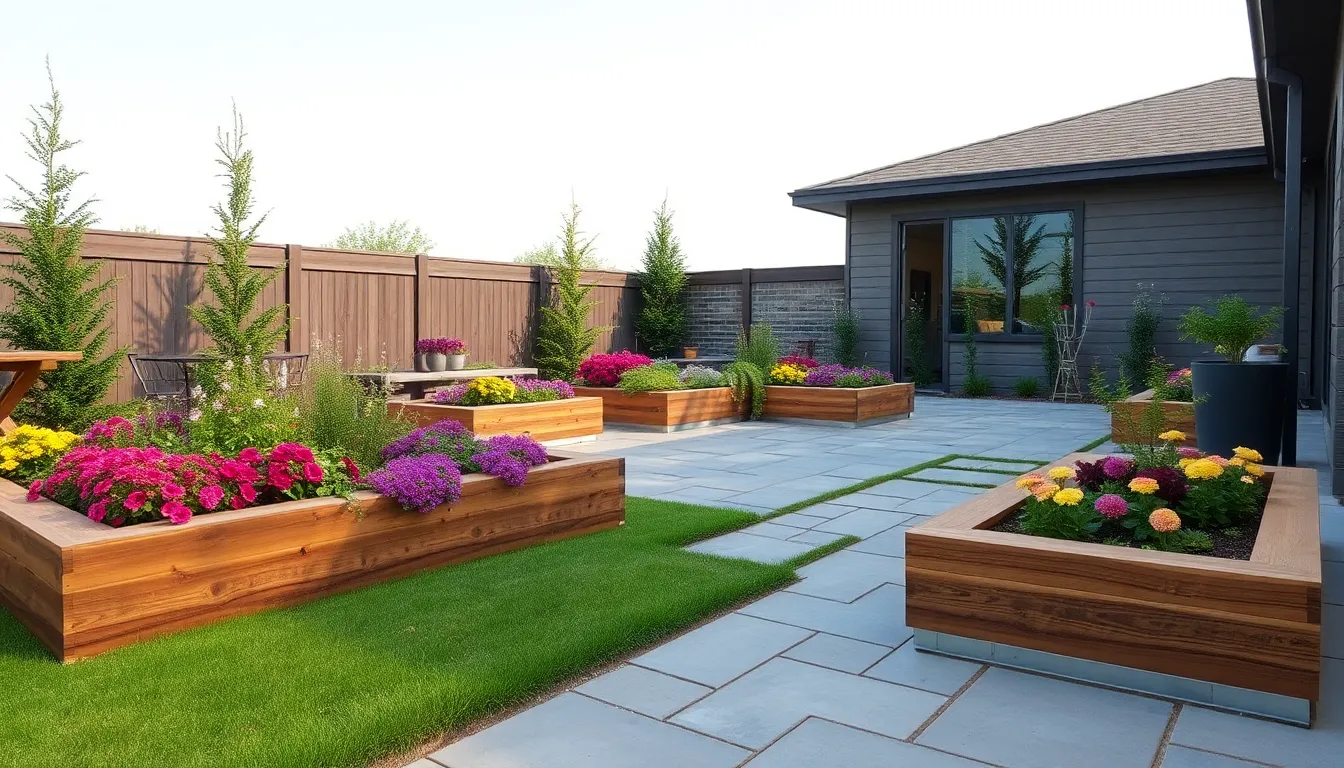
Raised border structures create dimension and definition while preventing soil spillage from your patio landscaping areas. These elevated boundaries serve dual purposes as both functional retaining elements and attractive design features that can double as seating ledges.
Timber Retaining Wall Borders
Railway sleepers and natural wood timbers offer the most popular choice for creating rustic raised borders around patios. We recommend using treated timber that resists rot and insects, ensuring your investment lasts for years. These materials bring warmth and vintage charm to any outdoor space while being surprisingly easy to install.
Curved or straight timber borders work equally well for raised garden beds and terraced patio designs. The natural wood aesthetic complements both traditional and contemporary landscaping styles. Railway sleepers provide exceptional durability and can support important soil weight, making them perfect for sloped areas that require structural support.
Concrete Block Raised Edges
Concrete blocks deliver unmatched versatility and durability for raised patio borders of varying heights and shapes. We’ve found that modern concrete blocks come in many colors and textures, including stone-look finishes that blend seamlessly with natural surroundings. This weather-resistant material requires minimal maintenance once installed.
Stacked concrete blocks create clean, modern lines that define garden spaces with precision. The structural support they provide makes them ideal for sloped landscapes where soil retention is crucial. Different block sizes allow for creative stacking patterns that add visual interest while maintaining functionality.
Metal Edging Answers
Steel and aluminum edging systems provide the sleekest contemporary look for raised patio borders. We appreciate their flexibility in shaping curved or straight lines while creating precise separation between patio materials and planting areas. Metal edging effectively prevents grass encroachment and mulch spillage with its low-profile design.
Durability stands as the primary advantage of metal edging answers, lasting decades without replacement. The unobtrusive appearance maintains clean sight lines while providing highly functional boundaries. Installation proves straightforward, and the material adapts to any industry contour without compromising structural integrity.
Add Decorative Gravel and Mulch Borders
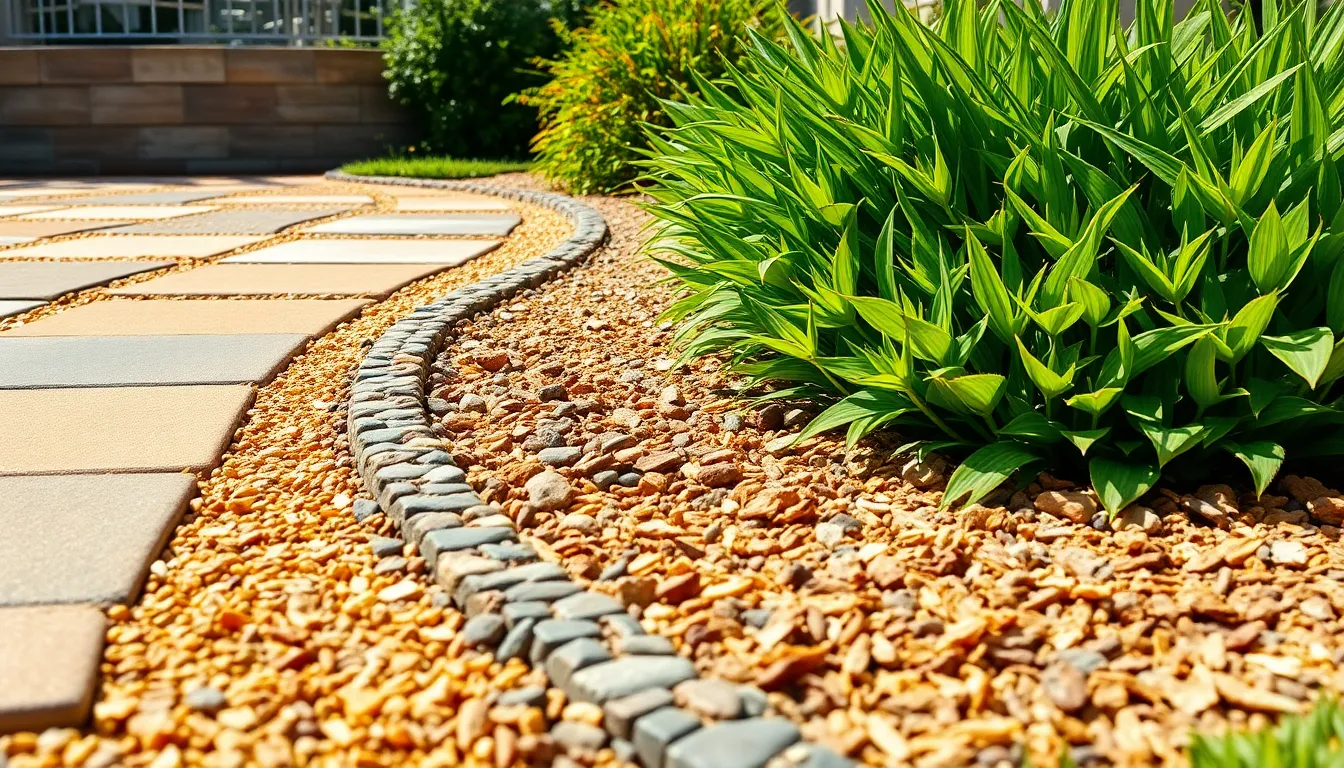
Decorative gravel and mulch borders offer practical and beautiful answers for defining your patio edges while creating stunning visual transitions. These materials provide excellent drainage, require minimal maintenance, and enhance the overall aesthetic appeal of your outdoor space.
Colored Gravel Border Designs
Colored gravel transforms ordinary patio borders into vibrant design features that complement your garden’s color palette. We can choose from various sizes, shapes, and brilliant hues to create customized looks that match our exact design vision. Purple slate chips, golden decomposed granite, and red lava rock provide dramatic color contrasts against neutral patio materials.
Combining colored gravel with other materials like pavers or bricks creates visually ever-changing and low-maintenance patio edges. Mixed stone and gravel combinations deliver layered, textured appearances that enhance the overall industry design. Blue recycled glass mulch paired with white marble chips creates striking contemporary borders, while earth-tone river rocks mixed with brown pea gravel offers natural, organic transitions.
Strategic placement of different colored gravels can define separate garden zones or highlight exact plantings. Lighter colored gravels like white limestone reflect heat and work well in sunny areas, while darker options such as black basalt absorb heat and suit cooler microclimates.
Organic Mulch Applications
Organic mulches such as bark chips and wood mulch provide natural appearances while delivering important soil benefits for patio border plantings. These materials help maintain consistent soil temperature, conserve moisture, and improve soil fertility as they decompose over time. Shredded cedar bark offers natural pest resistance and pleasant aromatics, while hardwood mulch provides rich, dark coloring that complements most plant combinations.
Organic mulch applications soften the hard edges of patios and create seamless transitions from hardscape to garden areas. We can use different textures and colors of organic mulches to create visual interest and define planting zones. Fine bark mulch works well around delicate perennials, while chunky wood chips suit larger shrubs and trees.
Proper application depth ensures optimal performance and appearance of organic mulch borders. Two to three inches provides adequate weed suppression and moisture retention without suffocating plant roots or creating pest harboring areas.
Decorative Rock Gardens
Decorative rock gardens serve both functional and ornamental purposes in patio border landscaping designs. Layered or stacked rocks provide excellent erosion control and moisture retention while creating stunning focal points throughout the industry. Natural fieldstone, weathered limestone, and colorful sandstone offer diverse textures and colors to match surrounding design elements.
Rock selection and arrangement strategies determine the overall aesthetic impact of decorative rock garden borders. We can create formal stacked stone walls for structured appearances or arrange boulders naturally for organic, flowing designs. Flat flagstones work well for low border walls, while rounded river rocks create gentle, curved transitions.
Integrating rock gardens with planted areas creates ever-changing, multi-dimensional borders that provide year-round visual interest. Drought-tolerant plants like sedums, ornamental grasses, and native wildflowers thrive in rock garden environments and require minimal irrigation once established.
Incorporate Water Feature Borders
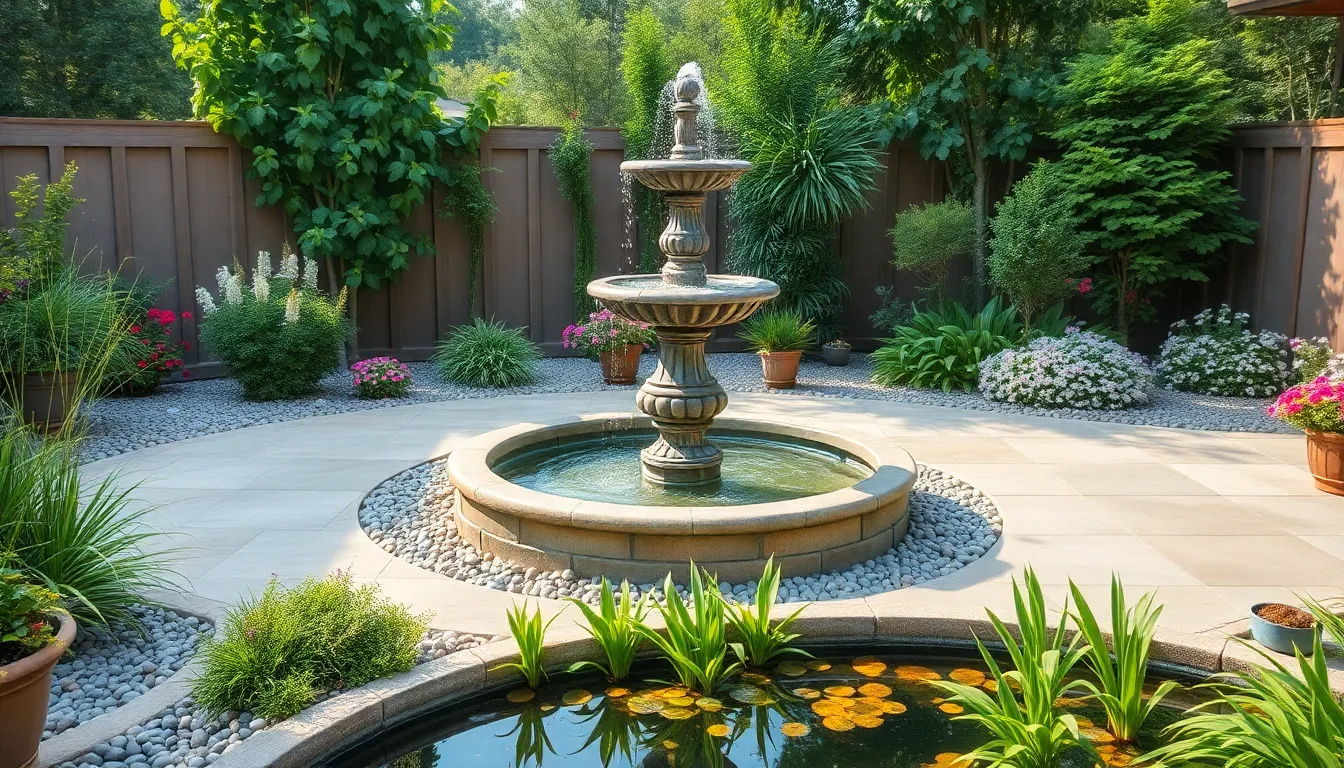
Water feature borders transform ordinary patio edges into tranquil retreats that blend natural beauty with functional design. We’ll explore how fountains, ponds, and proper drainage create stunning transitions between your patio and surrounding industry.
Small Fountain Installations
Freestanding fountains serve as elegant focal points along patio edges, offering versatility in placement and style options. We can choose from traditional stone designs, modern minimalist styles, or tiered configurations that complement our existing outdoor décor. Wall mounted versions work exceptionally well for smaller spaces, maximizing impact while conserving ground area.
Fountain sizing matters significantly for patio border applications, with compact models typically measuring 2-4 feet in height providing ideal proportions. These installations create gentle water sounds that enhance outdoor ambiance without overwhelming conversation areas. Pairing small fountains with surrounding planting beds or decorative gravel borders creates attractive layered looks that define patio boundaries naturally.
Installation flexibility allows us to position fountains strategically along curved or straight patio edges based on our space requirements. Electric fountains offer consistent water flow, while solar powered options provide eco friendly operation in sunny locations. We can enhance these features with subtle industry lighting to create stunning evening focal points.
Border Pond Designs
Shallow border ponds create organic transitions between patios and garden areas, typically extending 12-18 inches deep along patio edges. We integrate natural boulders and custom stone carvings to establish authentic looking water features that blend seamlessly with existing landscaping. These ponds accommodate aquatic plants like water lilies and lotus varieties that add color and texture.
Stream integration enhances border pond designs by incorporating gentle waterfalls or flowing channels that connect multiple pond sections. We can design these water flows to follow natural contours, creating peaceful sounds while providing visual movement along patio perimeters. Rock lined channels direct water movement while preventing erosion around patio foundations.
Wildlife habitat benefits emerge naturally from border pond installations, attracting birds, beneficial insects, and small wildlife to our outdoor spaces. Shallow areas provide drinking access while deeper sections support fish populations in larger pond designs. We position these features to offer viewing opportunities from patio seating areas while maintaining safe distances from high traffic zones.
Drainage Integration Tips
Gravel lined trenches channel excess water away from patio foundations, preventing structural damage and standing water issues. We create these drainage systems using 6-12 inch wide channels filled with coarse gravel that allows rapid water absorption. Strategic placement around water features ensures proper runoff management during heavy rainfall periods.
Sloped border design directs water flow toward designated drainage areas or landscaped zones that can handle moisture naturally. We grade these slopes at 2-3% gradients to encourage water movement without creating erosion problems. Permeable paver materials for patio surfaces allow natural water absorption while maintaining stable walking surfaces.
French drain installation provides discreet below ground drainage answers for areas with heavy water feature usage or poor soil drainage. We position perforated drainage pipes 12-18 inches below surface level, surrounding them with gravel and industry fabric. These systems effectively manage runoff from fountain basins and pond overflow while remaining invisible to patio users.
Rock bed integration combines functional drainage with decorative appeal, using river rocks and decorative stones to create attractive water management zones. We size these installations based on anticipated water volumes, typically using 3-6 inch rock diameters for optimal drainage performance. Proper installation prevents water pooling while adding textural interest to patio border designs.
Choose Low-Maintenance Border Solutions
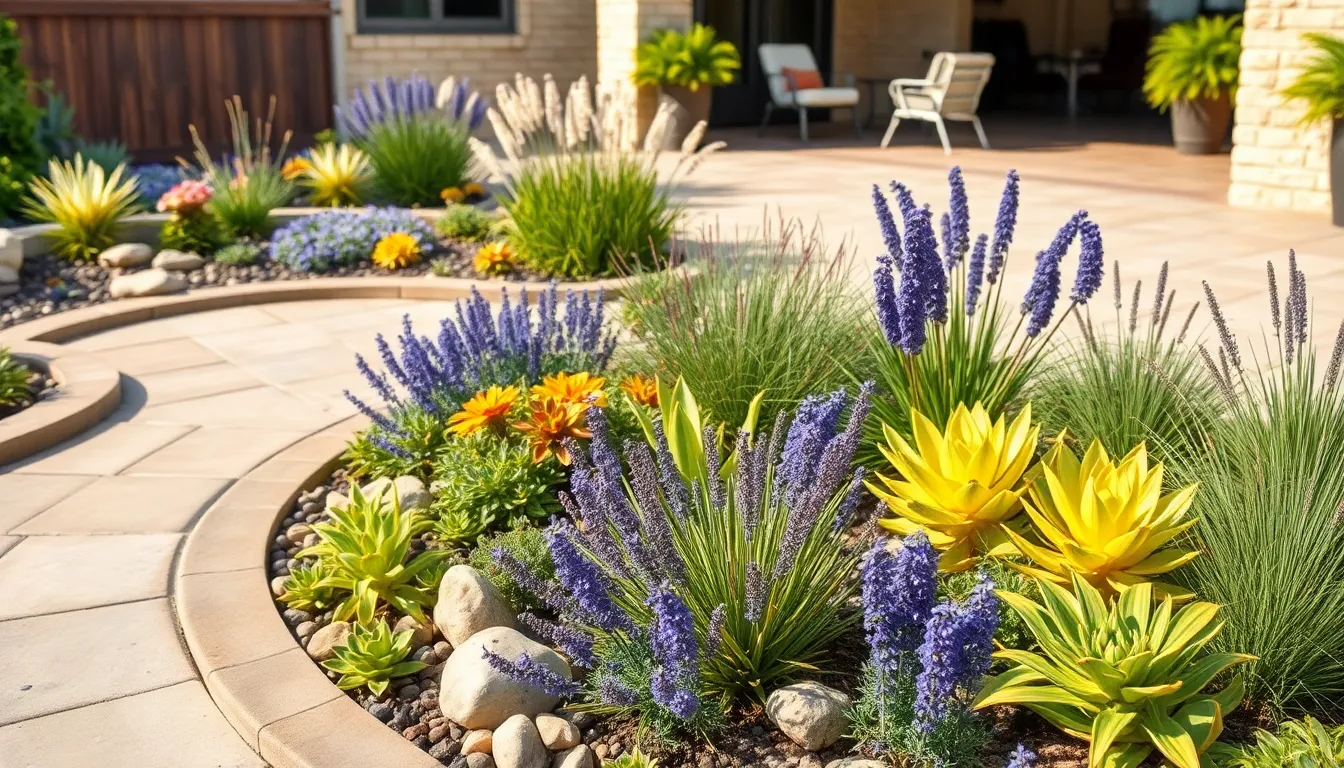
Building on traditional materials and living borders, we’ll explore practical answers that minimize maintenance while maximizing visual impact for your patio landscaping projects.
Drought-Resistant Plant Options
Native succulents create stunning borders that thrive in dry conditions without constant watering. Lavender plants offer fragrant purple blooms while requiring minimal water once established, making them perfect for Mediterranean-style patio borders. Ornamental grasses like fountain grass and blue fescue provide texture and movement with virtually no irrigation needs after their first growing season.
Yucca plants deliver architectural interest with their sword-like leaves and dramatic flower spikes, surviving harsh drought conditions better than most traditional border plants. We recommend grouping these drought-tolerant species together to create cohesive designs that naturally complement each other’s water requirements. Desert marigolds and blanket flowers extend the color palette while maintaining the same low-water philosophy throughout your patio border design.
Synthetic Material Alternatives
Plastic industry edging delivers clean definition between patio areas and garden beds while resisting weather damage for years without replacement. These flexible borders come in various colors and widths, allowing customization that matches your existing patio materials perfectly. Metal edging systems provide sleek, modern lines that create precise separation between different industry zones with minimal maintenance requirements.
Synthetic mulch alternatives like rubber bark suppress weeds effectively while retaining soil moisture longer than organic options. We’ve found that these materials eliminate the need for annual mulch replacement, saving both time and money over traditional wood chips. Composite border strips combine recycled materials with durability, offering eco-friendly answers that won’t warp, crack, or fade like natural alternatives.
Minimal Upkeep Designs
Pebble moat designs create visual interest around patio edges using multi-level layouts filled with decorative stones that require only occasional cleaning. Gravel borders add texture and color while preventing weed growth naturally, needing almost no care beyond periodic raking to maintain their appearance. Rock garden arrangements use layered stones to reduce erosion and retain soil moisture while adding natural beauty to your patio perimeter.
Brick edging provides budget-friendly borders that install easily and maintain their neat appearance with minimal cleaning requirements. Terracotta pot borders offer structured design elements that add color and height variation without demanding intensive plant care when used as decorative containers. Woven bamboo borders create privacy screens with natural materials that adapt to curved layouts, requiring replacement every few years but offering immediate visual impact with minimal daily maintenance.
Budget-Friendly Border Ideas
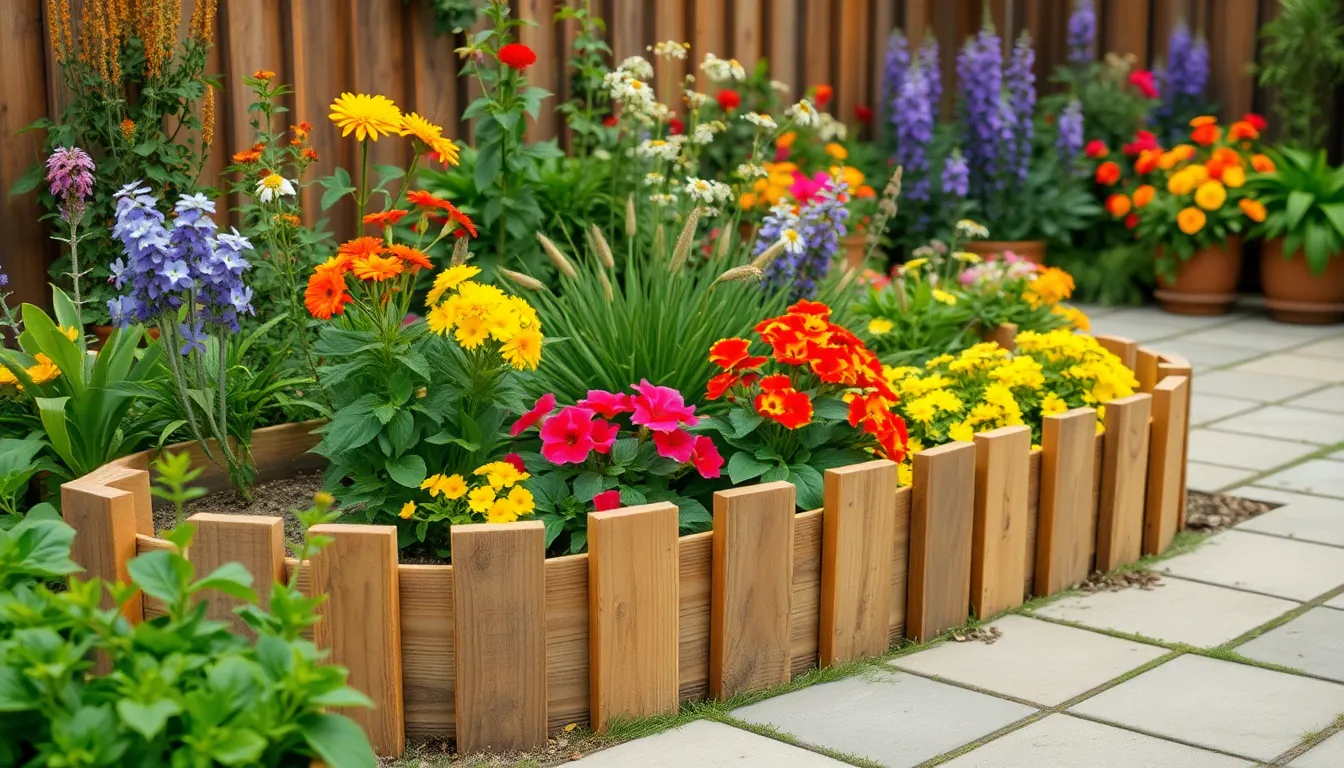
Creating stunning patio borders doesn’t require very costly when you know which materials and methods deliver maximum impact for minimal cost.
DIY Installation Projects
Lumber frame borders offer the quickest entry point into raised garden bed construction, requiring only basic carpentry skills and minimal tools. We can nail together simple wooden frames using inexpensive lumber to create instant definition around your patio space.
Plastic edging systems install with zero heavy equipment needed, making them perfect for weekend warriors tackling curved border designs. Flexible garden edging comes in multiple sizes and colors to match diverse patio styles while maintaining professional appearance.
Concrete poured edges create organic, lasting border lines that we can customize to any shape or size around existing hardscaping. Basic concrete mixing and pouring techniques produce durable results that rival expensive professional installations.
Flower bed edging stones contain soil and mulch effectively while improving visual appeal through manageable DIY placement projects. Stone and concrete edging pieces stack easily without mortar for beginners seeking immediate gratification.
Repurposed Material Options
Railroad ties from salvage sources deliver rustic charm and sturdy construction at fraction of retail pricing. Reclaimed railroad ties add natural character while recycling durable wood that would otherwise occupy landfill space.
Wooden pallets and industry timbers transform into terraced or flat garden borders with rustic appeal through simple disassembly and repositioning. Old wooden materials often come free from construction sites or businesses looking to dispose of excess inventory.
Brick and concrete salvage provides classic border materials at dramatically reduced costs compared to new purchases. Demolition sites and renovation projects frequently offer quality bricks and concrete blocks for minimal fees or free removal.
Cost-Effective Plant Choices
Hedge borders using boxwood or privet establish natural, lush boundaries requiring minimal upkeep while providing privacy and wind protection. Low maintenance shrubs offer year round structure without constant pruning or replacement expenses.
Native plant selections reduce watering and maintenance costs significantly by thriving in local soil and climate conditions. Drought tolerant species eliminate irrigation system investments while supporting local network health.
Groundcover combinations like mulch chips and pebbles complement plantings affordably while suppressing weed growth around border areas. Organic mulches break down slowly to improve soil quality while decorative stones provide permanent coverage answers.
| Material Type | Average Cost per Linear Foot | Installation Difficulty | Maintenance Level |
|---|---|---|---|
| Gravel edging | $2-4 | Easy | Minimal |
| Railroad ties | $3-8 | Moderate | Low |
| Plastic edging | $1-3 | Easy | Minimal |
| Concrete borders | $4-10 | Moderate | Very low |
| Native plants | $5-15 | Easy | Low |
Maintain Your Patio Border Landscape
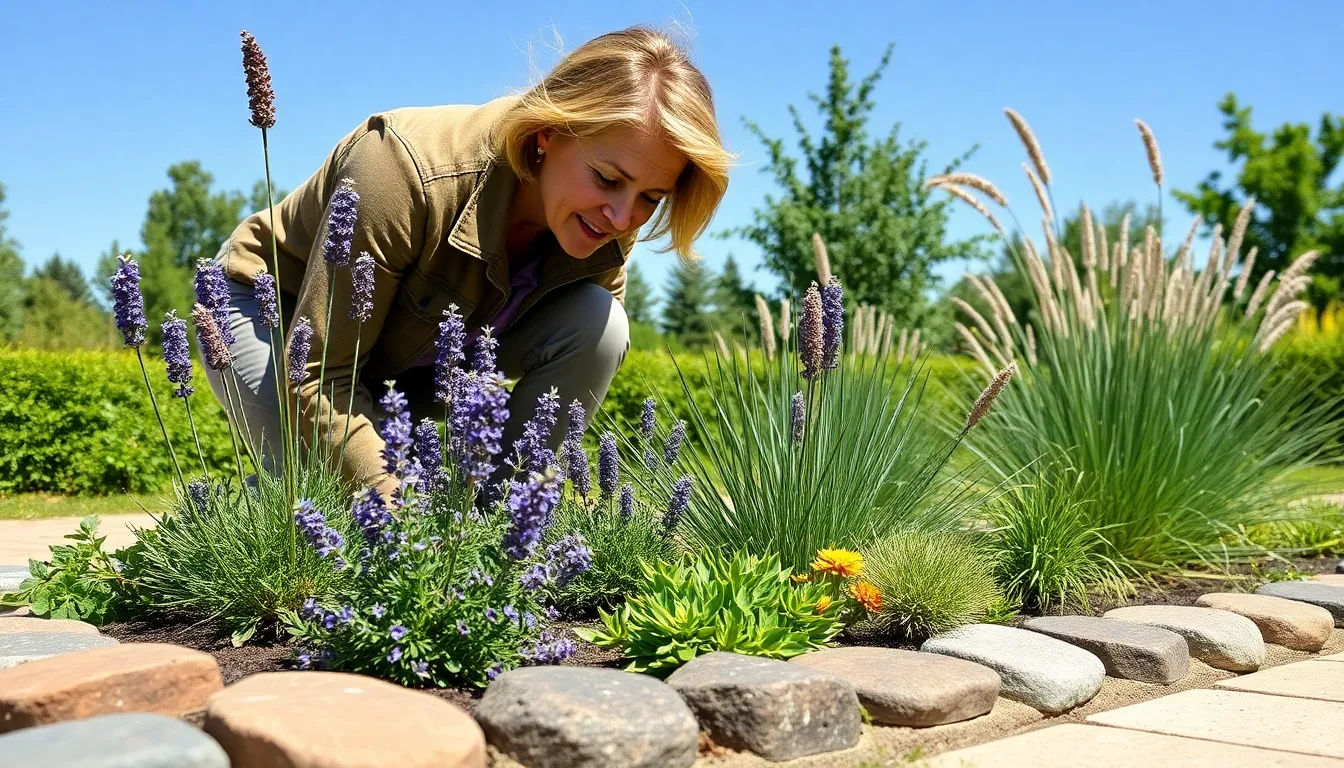
Proper maintenance keeps your patio border landscaping looking beautiful and functional throughout the year. We’ll walk you through essential care practices that preserve your investment and enhance your outdoor space’s appeal.
Seasonal Care Requirements
Spring and summer demand regular debris clearing and damage inspections for all edging materials. We recommend checking brick borders, stone walls, and metal edging systems weekly during growing season to catch issues early. Watering schedules become crucial during hot months, especially for newly planted perennial borders and drought-resistant plants like lavender and ornamental grasses.
Fall preparation involves removing fallen leaves from gravel borders and preparing living hedges for winter dormancy. We suggest applying fresh mulch around boxwood and privet hedges while protecting sensitive plants with burlap wraps. Drainage checks around concrete block raised edges prevent water accumulation that leads to frost damage.
Winter inspections focus on hardscape elements like gabion walls and railroad tie borders for frost-related damage. We examine brick and paver patterns for shifting or cracking caused by freeze-thaw cycles. Proper drainage around raised border structures prevents erosion and maintains structural integrity throughout cold months.
Pruning and Trimming Guidelines
Living borders require exact timing for optimal health and appearance. We prune boxwood, privet, and yew hedges during late winter or early spring before new growth begins. Light trimming throughout the growing season maintains neat geometric shapes and encourages dense, healthy foliage.
Perennial plant borders benefit from deadheading spent flowers and removing damaged stems promptly. We trim creeping thyme, sedum, and ajuga after flowering to promote continued growth and prevent overcrowding. Ornamental grasses need cutting back to 6 inches in late winter before new shoots emerge.
Disease prevention starts with removing dead or diseased branches immediately upon discovery. We sterilize pruning tools between plants to prevent spreading infections throughout living borders. Proper air circulation through selective pruning reduces fungal problems in dense hedge plantings.
Long-Term Maintenance Tips
Hardscape border inspection should occur twice yearly to maintain straight, secure edges. We reset shifted brick borders and replace damaged pavers or stones as needed. Checking gabion wall integrity ensures wire caging remains secure and rock fill stays properly contained.
Material replacement schedules depend on border type and local weather conditions. We replace weathered railroad ties every 10-15 years and refresh timber retaining walls when wood shows important decay. Concrete edges typically last decades with minimal maintenance beyond crack sealing.
Weed control strategies vary by border material but remain essential for neat appearances. We maintain sharp soil edges with spade work around natural stone borders and apply pre-emergent herbicides near gravel installations. Regular weeding prevents invasive plants from compromising border integrity and plant health.
Soil health monitoring ensures living borders receive adequate nutrition and drainage. We test soil pH annually and adjust with amendments as needed for optimal plant growth. Fertilizing schedules depend on exact plant requirements, with native plants typically needing less frequent feeding than exotic species.
Conclusion
Creating beautiful patio borders doesn’t have to overwhelm your budget or schedule. We’ve shown you many ways to transform your outdoor space using everything from natural stone and living plants to budget-friendly DIY answers.
The key to success lies in matching your border choice to your lifestyle and maintenance preferences. Whether you opt for low-maintenance gravel designs or vibrant seasonal plantings your patio will benefit from the defined structure these borders provide.
Remember that great patio landscaping evolves over time. Start with one border section and gradually expand your design as your confidence and experience grow. Your outdoor oasis awaits – it’s time to turn these ideas into reality.
Frequently Asked Questions
What is patio border landscaping and why is it important?
Patio border landscaping involves creating defined edges around your patio using various materials and plants to separate the paved area from surrounding landscapes. It’s important because it enhances curb appeal, increases property value, creates visual definition, and establishes a harmonious connection between indoor and outdoor living spaces.
What are the main types of patio border designs?
The three main types are formal, informal, and transitional designs. Formal borders feature structured elegance with geometric patterns and symmetrical plantings. Informal borders embrace natural curves and mixed plant combinations for a relaxed feel. Transitional styles blend both approaches, offering versatility in design.
What materials can I use for patio borders?
Popular materials include natural stone (flagstone, river rock, stacked stone), decorative brick and pavers, living plants (perennials, evergreens), raised structures (timber, concrete blocks), metal edging systems, and decorative gravel or mulch. Each material offers different aesthetic and functional benefits.
What are the best low-maintenance plants for patio borders?
Excellent low-maintenance options include drought-resistant plants like native succulents, lavender, ornamental grasses, and yucca. For living borders, consider creeping thyme, sedum, ajuga, boxwood, and privet. These plants require minimal watering and upkeep while providing year-round visual appeal.
How can I create patio borders on a budget?
Budget-friendly options include DIY installation projects using lumber frames or plastic edging, repurposing materials like railroad ties or salvaged bricks, and choosing cost-effective plants like native species. Poured concrete edges and basic flower bed edging stones are also affordable, manageable DIY solutions.
What maintenance do patio borders require?
Maintenance varies by material but generally includes seasonal inspections, debris clearing, pruning living borders, weed control, and soil health monitoring. Spring and summer require regular upkeep, fall involves winter preparation, and winter needs frost damage inspections. Hardscape elements need periodic cleaning and repair.
How do I choose between formal and informal border styles?
Consider your home’s architecture, personal preferences, and lifestyle. Formal borders suit traditional homes and structured landscapes, requiring more maintenance for precise appearance. Informal borders work well with cottage-style homes and natural settings, offering easier maintenance and a relaxed atmosphere.
What should I consider for seasonal interest in patio borders?
Plan for year-round appeal by selecting plants that provide continuous interest across seasons. Use layered planting strategies combining evergreens for winter structure, spring bulbs for early color, summer perennials for peak blooms, and plants with interesting fall foliage or winter berries.

